Decking: types of "terrace" garden parquet and methods of its installation
Decking is a floor covering made up of individual modules (in the form of boards or tiles) designed for outdoor use. With the help of decking, an even and aesthetic wooden coating is created that is resistant to weathering and temperature extremes. Unlike a conventional wooden floor (parquet, for example), decking has increased moisture resistance. This allows you to use it on open terraces, areas in front of the pool, garden paths. However, the use of decking is not limited to the personal area, more and more often it can be found as a floor covering of balconies, saunas, baths, indoor pools, bathrooms and kitchens. A huge advantage of decking is also the ease of installation, which any home master can handle.
Types of decking: board or tile?
There are two types of coverage that are called decking:
- terrace (deck) board;
- garden parquet.
The terrace board has the appearance of a regular wooden board with a length of 1.5 - 6 m. Its front side can be both smooth and rough - for anti-slip effect.

Garden parquet is a square tile with side dimensions of 30x30 cm or 50x50 cm. Such a tile is heterogeneous in its structure and consists of two layers. The bottom layer is a frame substrate made of plastic or wood. On it with the help of self-tapping screws, the front strips of the decking are fixed - lamellas.
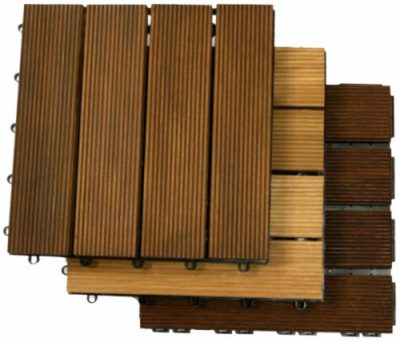
What is decking made of?
As a material for decking, valuable hardwoods can be used - teak, mahogany, kumaru, azobe, kempas. These are tropical species that have natural moisture resistant properties due to their growth in humid tropical zones. The only drawback of such exotic is the high cost. Therefore, moisture-resistant, but less expensive cedar or larch wood is often used instead.
Decking wood should be maximally adapted for outdoor use, therefore, manufacturers often conduct heat treatment - dousing with hot steam without air. In this case, moisture is removed from the tree and the material gains new properties: it does not dry out in the sun, does not swell from moisture, does not crack, does not deform, and does not turn blue with time. Also, wood becomes lighter in weight, acquires an even, beautiful shade.
Also, for the manufacture of decking, a wood-polymer composite (WPC) is used. This is a homogeneous mixture of thermoplastics with wood flour (which is most often sawmill waste), which has high strength, moisture resistance, low thermal conductivity. The more wood in the WPC, the more in its characteristics it will resemble a tree, the less - plastic. On average, the percentage of wood particles in the composite material varies from 60% to 80%. Sometimes this material is called liquid wood because of its plasticity and kinship with natural wood.
Technologies for installing terrace tiles
You can mount garden parquet tiles on almost any surface: concrete, ceramic tile, old plank floor, gravel or crushed stone dumping, and soil. The sand cushion is not very suitable for these purposes, since the modules laid on it will bend and push into the sand. Nothing bad will happen to the material, but the surface of the floor will “play” and become uneven. It is also advisable if you decide to fix the modules on the ground, first clear it of stones and lay geotextiles on the surface, which will inhibit plant growth.
The decking deck does not require any special preparation. The main thing is that this surface is relatively flat and the level differences do not exceed 5 mm per 1 m2.
Mounted garden parquet very quickly. For laying 1 m2 tiles will take just a couple of minutes! Tiled modules are simply fastened together using lock joints. In the event that during installation it is necessary to leave room for various protrusions, pipes or other structures, then the interfering parts of the modules can be easily trimmed. This is done with a conventional saw.
How to mount a terrace board?
The terrace board is mounted a little differently. It is fixed not on the base itself (it can be any flat, not deformable surface), but on wooden support logs.
To begin with, it is necessary to lay logs on the surface, observing a distance of 36-50 cm between them. The step is selected depending on the length of the terrace board, that is, the shorter the board, the smaller the distance between the logs and vice versa. If necessary, the lags are fixed on the surface using self-tapping screws. If you plan to use a terrace board in humid or outdoor conditions, you need to leave a small distance between the lags and the surface - to drain excess water. This is done by placing solid objects under the logs, most often ceramic tiles.
Next, special mounting clips are installed in the grooves of the boards, which are fixed with screws on the logs. The next board is simply inserted with a groove in these clips. All other boards are laid in the same way. For finishing decking around the perimeter of the flooring, stubs can be used that hide the side grooves of the edge boards.

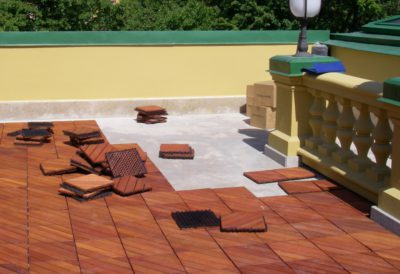
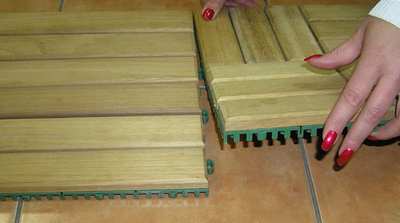
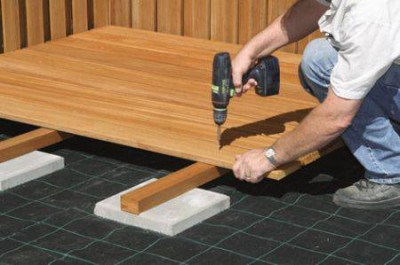
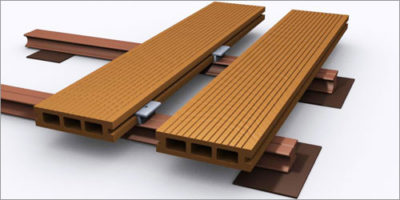


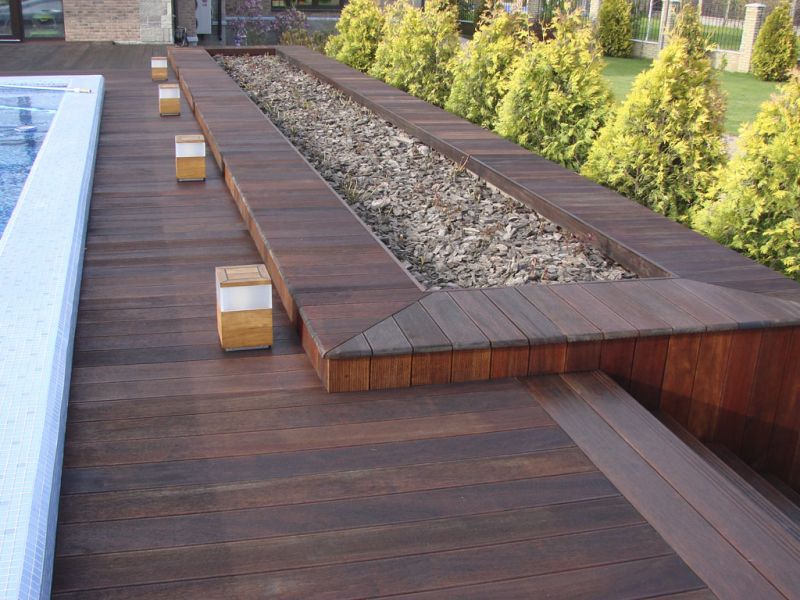
3 comments